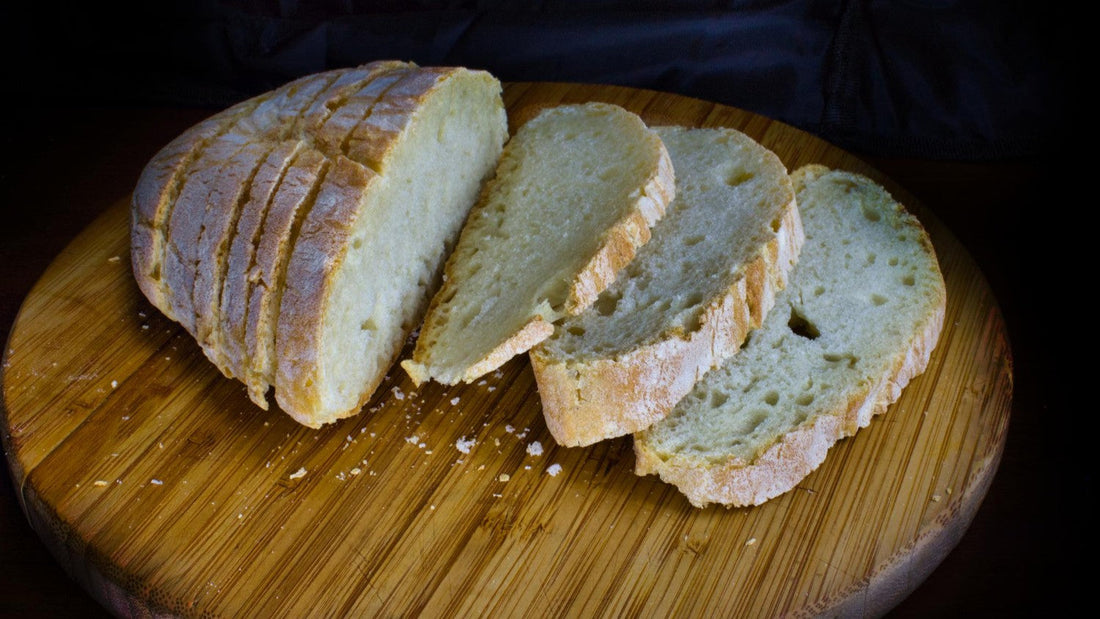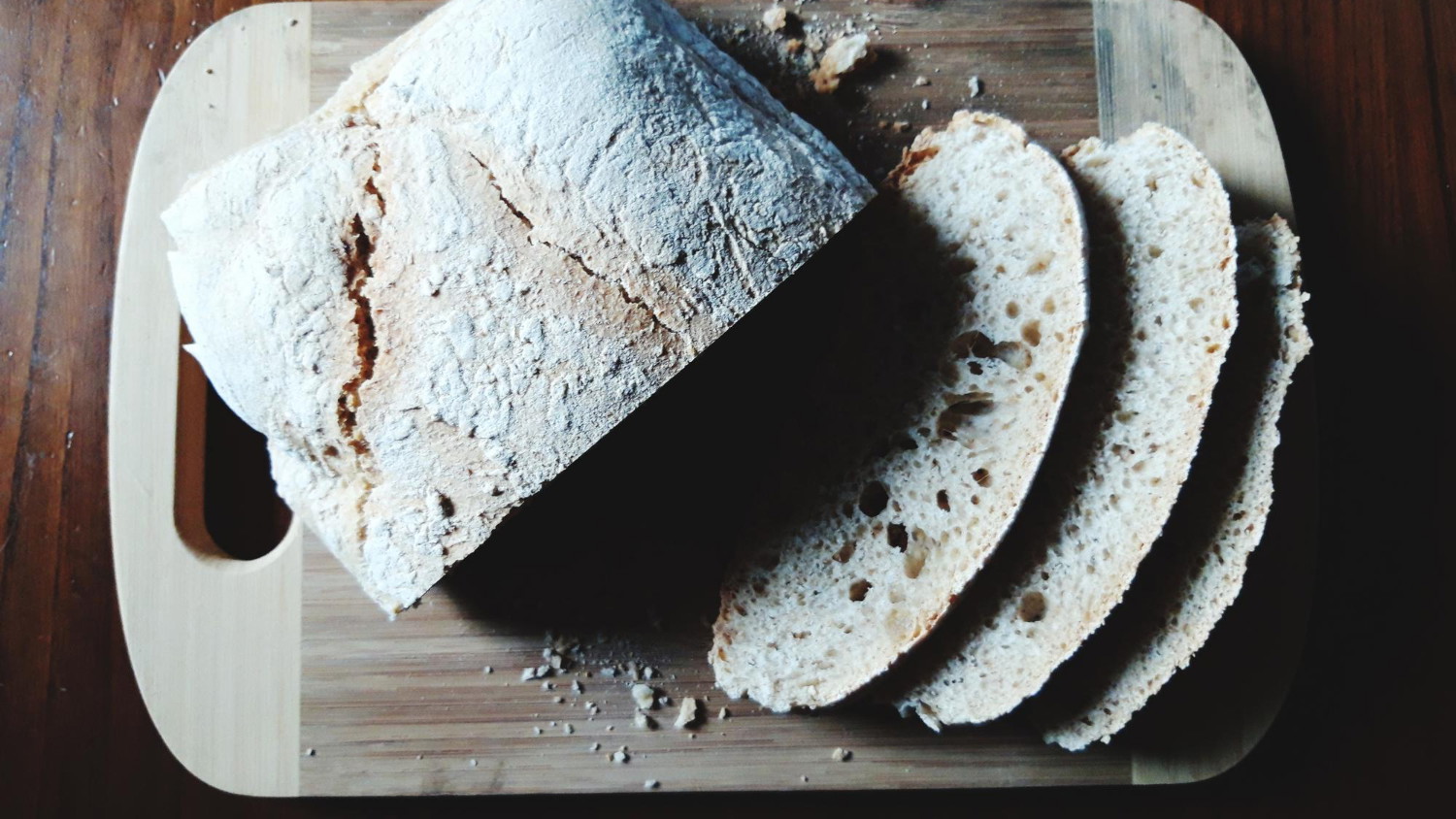
Easiest No-Knead Bread Recipe Without a Dutch Oven
Share
AThere’s nothing fussy about no-knead bread, just flour, water, yeast, and time coming together while life carries on in the background. This recipe isn’t about chasing artisan perfection; it’s about something warm, homemade, and doable without standing over dough like a drill sergeant.
The yeast does all the work building flavor and texture. This recipe makes breadmaking less challenging for new bakers, busy parents, or anyone with limited time or mobility. Serve golden, crusty loaf without a Dutch oven or other expensive tools required.
Ingredients
Bread Flour (3½ cups): Bread flour makes the loaf taller and chewier because it has more protein. Using this kind of flour helps your bread turn out lighter and airier.
Warm Water (13 oz / about 1⅔ cups): Water temperature really matters. Use warmer water if your kitchen is cold, cooler water if it’s hot. Keep your final dough temp around 75°F or higher 75°F, so it rises well.
Instant Yeast (1¼ tsp): Instant (or bread machine yeast) rises quicker in part because the grains are finer.
Salt (1½ tsp): Salt gives flavor and also helps the dough hold its shape. Too little makes bread taste flat, but too much can slow down the yeast.
Tips on Making No-Knead Bread
- Room temperature affects how fast dough rises and how active the yeast is. Cold kitchens = slower rise, so don’t panic if it takes longer.
- Stretch and folds add structure and prevent flat, floppy bread.
- An overnight fridge rest after folding improves flavor and makes dough easier to handle.
- Always aerate flour before measuring. Compact flour = too much flour = dense, dry bread.

Best Way to Bake No-Knead Bread with No Dutch Oven
A Dutch oven is popular for no-knead recipes because it nails two important things: it gets hot (really hot), and it traps steam. That steam keeps the crust soft just long enough for the bread to rise tall before crisping up.
A wood-fired oven does both of these even better, reaching higher heat and naturally creating steam for a beautifully risen loaf with a rustic, crackling crust.
- Two lasagna pans: One on bottom, one flipped on top, clip together if wobbly.
- Pyrex dish with lid: Only if oven-safe up to 450°F. Start cold, never preheat.
- Stainless steel pot with lid: Preheat both pot and lid, add dough on parchment, cover to trap steam.
- Pizza steel + stainless mixing bowl: One of the best hacks. Preheat steel, place dough on parchment, cover with inverted bowl. Almost like a mini wood-fired oven right in your kitchen.
- Black cast iron pot with lid: Preheat, parchment in, lid on 30 minutes, then off for the crust. Works even better inside a wood-fired oven for bold flavor and deeper browning.
-
Cast iron skillet + foil: Preheat skillet, dough on parchment, seal with foil. Simple, effective, and great for rustic bakes, especially in a wood-fired oven.

Why is My No-Knead Bread So Dense?
Dense bread usually comes down to a few common culprits. Sometimes the yeast is sluggish or inactive, which keeps the dough from rising properly. Other times it’s a matter of water balance, too much or too little can weigh the loaf down, which is why weighing ingredients is so important.
Underproofing is another big factor, since dough that hasn’t had enough time to rise bakes up heavy and tight. Flour strength also matters; bread flour with at least 11% protein gives better structure and a taller crumb. And finally, don’t overlook your oven setup, full preheating and a blazing hot vessel are key for that all-important oven spring.
Easiest No-Knead Bread Without a Dutch Oven
Rated 5.0 stars by 1 users
Category
Bread
Servings
1 Medium Loaf
Prep Time
14 hours
Cook Time
35-40 minutes
Golden, crusty, and chewy inside, this no-knead bread is all about simplicity. No mixer, no Dutch oven, no endless folding, just a few ingredients, some patience, and a hot oven. Using a pizza steel and stainless steel bowl, you’ll still get that bakery-style crust without special equipment. Perfect for beginners or anyone who wants fresh bread without the fuss.

Ingredients
- 13 oz warm water (about 1⅔ cups)
- 3½ cups bread flour
- 1¼ tsp instant yeast (bread machine yeast works great)
- 1½ tsp salt
Directions
Mix the Dough
- Adjust your water temperature to match your kitchen (warmer in winter, cooler in summer).
- In a mixing bowl, combine warm water, salt, and yeast. Stir briefly.
- Add bread flour and mix with a spatula until you have a shaggy, sticky dough. Scrape down the sides so no dry flour remains.
First Rise
- Cover the bowl with plastic wrap or a towel.
- Let rise 1 hour 30 minutes at room temperature, or until doubled and bubbly. (Tip: if your kitchen is cold, place the bowl in the oven with the light on for gentle warmth.)
Degas & Shape
- Use a spoon or spatula to gently fold the dough over itself a few times to release gas.
- Dust a surface with flour and tip the dough out. Sprinkle a little flour on top.
- Tuck the edges underneath to form a round with a smooth top. Place seam-side down on parchment paper while the oven preheats.
Preheat & Bake (using pizza steel)
Place a pizza steel on the middle rack and preheat your oven to 500°F for 45 minutes.
Note: Only the pizza steel, cast iron pot & cast iron pan need to be preheated for this long. lasagna pans, Pyrex dish & stainless steel pot do not need to be heated for so long.- Slide the dough (on parchment) onto the hot steel. Cover immediately with a stainless steel bowl to trap steam.
Bake for 30-40 minutes covered, then uncover and bake another 5-10 minutes until the crust is deep golden.
For extra crunch, turn off the oven, crack the door, and leave the loaf inside 5-10 minutes longer.
Recipe Note
Baking: In the 'Preheat & Bake" section, we went over using the pizza steel as the cooking method as we like that the best, but all other methods are the same.
Flour: Stick with bread flour (11% protein or higher) for better structure and rise.
Dough Texture: No-knead dough is sticky. Resist the urge to add too much flour.
Storage: Best eaten the same day. Leftovers keep 1–2 days in a paper bag; refresh by popping slices in the oven at 350°F for a few minutes.
